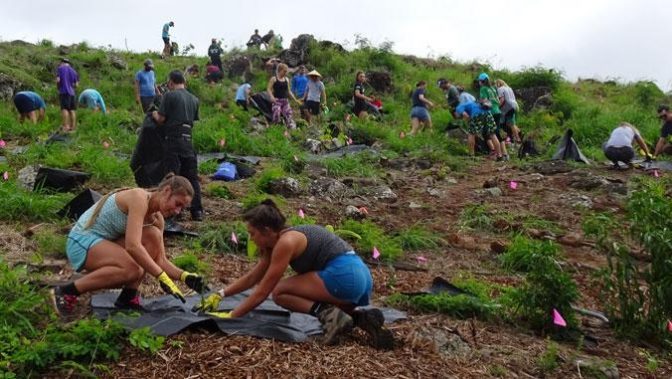By Staff Reports
(Hawaii)– Greenhouse gas emissions remain unabated despite increasing incidences of deadly heatwaves, hurricanes, floods, droughts, wildfires, and other climatic changes. However, it is possible to counteract the effects of carbon emissions by improving natural ecosystems to offset such emissions. This is the goal of the University of Hawaiʻi at Mānoa’s Carbon Neutrality Challenge project.
The Carbon Neutrality Challenge, a joint project by UH Mānoa and numerous organizations, aims to test the feasibility of restoring local ecosystems to offset all of the state’s carbon emissions.
Last October, the project held its first proof-of-concept event and planted a record-setting 1,000 trees in two hours. This year, the group plans to plant 11,000 trees on Saturday, October 26, to prove that it is possible to plant on the massive scale needed to position Hawaiʻi as the first place in the world to fully offset its carbon emissions via ecosystem restoration.
The project aims to scale up planting to 100,000 trees next year, and 1,000,000 tree plantings annually starting in 2021.
“Hawaiʻi could show the world how it is done. We could be the first. We have the space. We have the will. We just need the money,” says Camilo Mora, associate professor of Geography in the College of Social Sciences at UH Mānoa and lead investigator in the project.
The two biggest threats to newly planted saplings are weeds and a lack of water. Last year Mora’s team placed weed-blocking mats around each of the trees planted. This resulted in a 50 percent survival rate for the saplings.
This year, to address the water issue, a team led by Mora developed a low-cost, patent-pending watering system. The system captures rain water through a catchment system and stores it in a tank. Water flows out of the tank into the ground at a rate of one liter a day. The system collects enough water during the rainy season to last through the dry season, thus ensuring constant water to the trees, reducing mortality, and the need for constant maintenance. Each system costs only $4 to build, and is reusable for up to 10 years, bringing the cost of irrigation to just about $0.40 per tree. With the addition of the watering system, survival rates for the saplings are expected to rise to approximately 90 percent.
Go to uhfoundation.org/Trees to help support UH Mānoa’s efforts to reduce the state’s carbon footprint through forest restoration.
To ensure that each sapling planted on October 26 will have a watering system in place and the added protection of weed-control mats to increase its survival rate, the team is launching a crowdfunding campaign with a goal of $55,000.
“Each donation received brings us a step closer to our goal of making Hawaiʻi the nation’s first carbon-neutral state,” said Asryelle Mora Rollo, one of the creators of the project.
“In a not too distant future, our children could tell their children that we fixed climate change and left a forest behind. Alternatively, they could say we saw our planet being destroyed, and we did nothing or not enough,” said Mora. “The opportunity is there now for us to decide which future we want. The time to fix climate change is now, and planting trees is a given.”
Individuals interested in joining the tree-planting event on October 26 may sign up at: GoCarbonNeutral.org. Monetary support for the Carbon Neutrality Project and its tree planting initiatives may be made at: uhfoundation.org/Trees.
To learn more about the Carbon Neutrality Project and its tree-planting initiative, visit: https://vimeo.com/347015518.
More About the Carbon Neutrality Challenge: The Carbon Neutrality Challenge is led by Camilo Mora, associate professor of Geography in the College of Social Sciences at the University of Hawai‘i at Mānoa. His work on climate change has been showcased in The New York Times, The Washington Post, Newsweek, Time, Fortune, CNN, and even conservative channels such as Fox News and Breitbart, among many others. He is the author of over 65 scientific publications, three of which have been among the top 100 science stories in the world in 2017, 2013, and 2011. He is among one of Hawai‘i’s top 20 people to watch for the next 20 years according to Hawai‘i Business Magazine. The team also includes Asryelle Mora Rollo, who has taken on the job of showcasing the project to NGOs and schools; and Audrey Rollo who is in charge of operations.

